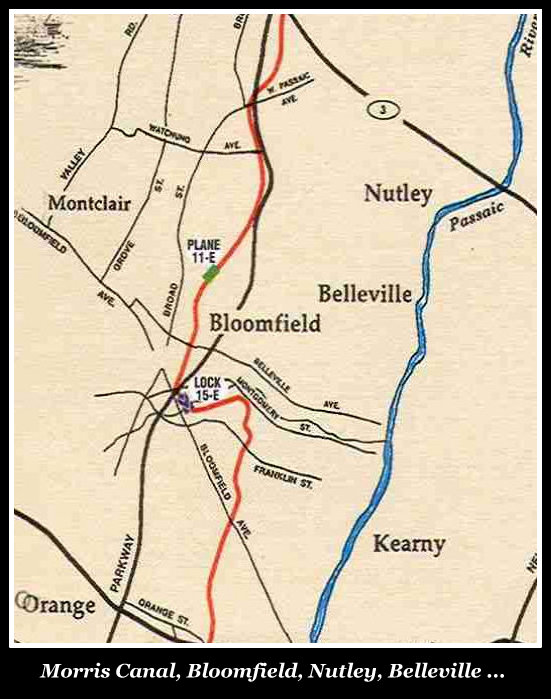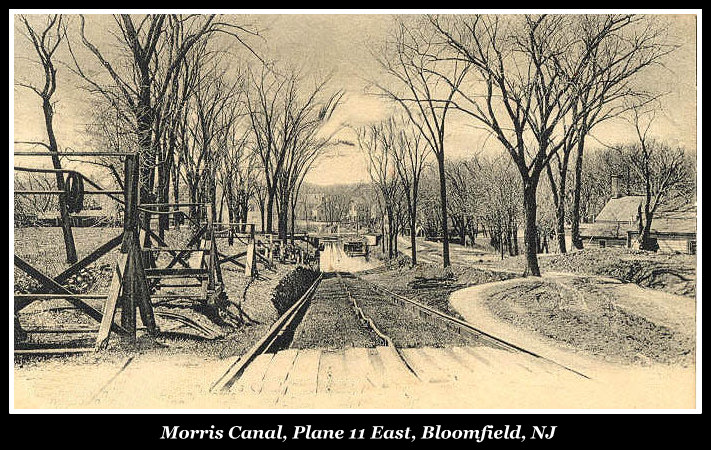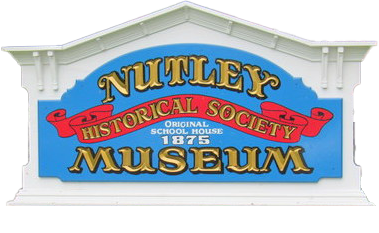By Pat Brightman, The Nutley Sun
Titus recollects on the old Morris Canal
In 99 years Richard Titus of Warren Street has done a lot of living and expects to do a lot more, which is why he was so pleased and excited when he was made an honorary member of the Canal Society of New Jersey.
Titus knows a thing or two about the canal, having worked on the legendary waterway for ten years in the early days of this century, four of them as captain of one of the massive cargo barges that plied the 102-mile commercial waterway.
Until recently, Titus knew nothing of the organization that is dedicated to uncovering the history of the canal and making sure its memory stays alive, but he paid a visit to Waterloo Village in Sussex County, where a full working section of the canal has been rebuilt and set up as a popular tourist attraction, and suddenly his identity became known to historians.
“I went there and they had a canal lock and didn’t even know it,” said Titus about his autumn visit to the historic site.
“They had horses pulling boats, but on the Morris Canal we used mules.
“A woman there asked me about double planes, she wanted to know where one was, and I was able to tell her where they were.”
They Called
After giving the workers at Waterloo a veritable reservoir of information on the canal, the society contacted Titus’ daughter Ruth Hannon.
“One of the officers got in touch with me and said they were very interested in my father,” said Hannon.
“I thought they would present him with something since he was one of the few left who know about the canal from actual experience.
At their meeting on the 15th, held in the Allied Chemical Signal Co., building, Morristown, members of the society presented Titus with a Canal Society of New Jersey jacket and a Richard Titus honorary member nametag that he has yet to take off, said Hannon.
“I went to the meeting but I didn’t know what it was for,” said Titus, “I certainly was surprised.”
The father of four and grandfather of two worked ten years on the canal, from 1897 to 1907, starting at the-age of nine. By the time he was 14 he was captain of his own 100 foot long, ten foot wide vessel that hauled a variety of cargos along the 102-mile canal that was as busy then in comparison as the New Jersey turnpike is today.
1903 flood
“I remember the 1903 flood at Pompton Feeder,” he said. “We returned to dock at about four o’clock and the dock was ten feet from the boat, we had to climb to get to shore. At one o’clock in the morning we heard the whistle blow, and the water, was in the streets, the canal had risen more than ten feet and was flooding the town because of a storm.
“Then the dam busted and away swept the bridge and houses. I lost a boat and someone drowned. We were trapped in a hotel for four days because of that storm.”
Remains of the canal are scarce, with much of the old trail being recarved for office buildings and other modern advances, including the Garden State Parkway, but a few zealous historians seek out knowledge of the canal and find ways of disseminating it.
The Canal Society meets regularly to further its goals, including canal. In Clifton, the Morris Canal Park and Nature Preserve is a nearby example of this campaign succeeding.
“Over 1,000 Irishmen built the canal by hand," said Jack Kuepfer, director of the Clifton organization. “They had no bulldozers or other earth moving equipment. It was picks, shovels, and wheel barrows to build the entire canal.
“Out in Western Jersey there were many copper(head) snakes,” he continued, “and this Irish were scared of snakes. They were told that liquor cured snakebites so they drank. Unfortunately, that didn’t work and many succumbed to snakebite.”
Where It began
The 102 mile waterway was the idea of George McCulloch, who believed a water way connecting Lake Hopatcong with the Delaware River and New York Bay would be successful for both the state and himself.
Construction began in October 1825 and by 1836 had reached the chosen destination, Jersey City, thereby joining the rich mining districts of Pennsylvania with New York Harbor.
Building and operations had some unexpected obstacles.
The Erie Canal, completed the same month the Morris project began, averaged less than a foot a mile in elevational change, whereas the Morris had an average change of 18 feet, creating elevation changes totaling 1,674 feet.
In an attempt to relieve this problem, the engineers used the traditional British technique of inclined planes and lift locks that allowed the boats to be pulled up or down by steam engines between two sections of the canal at different elevations.
"Since the canal was all manmade, it had to be lined with clay,” said Kuepfer, "otherwise the water would have seeped away.
“There was a problem with muskrats,” he continued. “They would dig through the clay into the dirt and let the water drain out through the tunnels they created.”
Shipping, recreation were activities on canal

If the Morris Canal met with only mild commercial success in its existence, its impact on Nutley was far more substantial.
“For much of the canal’s existences there was no Nutley,” said Jack Kuepfer, director of the Morris Canal Park and Nature Preserve in Clifton.
“I think when they determined the border for Nutley they used the canal line,” he continued, “Probably doing it out of convenience.”
Nutley’s western and a section of its southern border runs along the old canal. The town of Nutley was incorporated in 1902 but used boundaries of old Franklin Township, established in 1874. (The name Nutley came from an estate with the same name owned by the Satterthwaite family. The banks of the Passaic River where the estate set, had fields of nuts and “ley” is a common Sussex ending meaning field.)
While the canal’s primary purpose, transporting coal, iron ore, and limestone, was lost to many townspeople, it still conjures up memories of skating, swimming and picnicking.
“We’d go swimming in the summer and skating in the winter, said 99-year-old Richard Titus, a Nutley resident who worked on the canal for 10 years.
“The most enjoyable was when we were hacking, that is taking passengers, on pleasure cruises. It was just like taxies, only we didn’t use automobiles.”
According to Kuepfer, approximately 75 tons of material could be shipped by a boat through the canal. He also said rock was not the only item shipped.
“In summer and fall, the barges would bring vegetables and fruit to Newark and Jersey City,” he said. “On the way back out west, they would ship the horse manure because the cities had problems getting rid of it and the farmers would use it as fertilizer.”
Taking a Trip
A journey, start to finish, on the Morris Canal took five days, but as Titus noted a trip would take a week or so, depending on how long loading and unloading took.” The canalier, as they were called, worked six days a week, taking Sundays off.
Boats were usually manned by two men, the captain and the mule boy, but as Titus noted, some captains brought their families with them.
The boat would travel the canal and because Lake Hopatcong was 760 feet above the Delaware River at Phillipsburg and 914 feet above the Passaic River, by both land and water, they had that broad expanse of water for cruising.
Inclined planes and locks were used to assist the barges over such uneven terrain, while mules actually moved the boats and barges along the canal from well-trodden tow paths along its bank.
“They used mules because horses didn’t know when to stop,” said Kuepfer. “A horse would keep going until he dropped but a mule knew when he had enough and would just stop.”
While the canal was built as an opportunity to make money, an early version of today’s New Jersey Turnpike albeit a wet one, and one of the only ways to ship products, rich profits were not to be.
“The canal was never a money maker,” said Keupfer. “It had some good years during the Civil War, but the railroad came in and ruined it for the canal.
Titus made 89 cents per ton when he was captain of his boat, 100 feet long and 10 feet wide which was supplied by the companies wanting the items shipped. He made only $3 a week when he started his canal career at age nine as a mule boy.
The canal was not operational during the winter, and many of the canal workers stayed together during the winter months.
“We worked just the summer months because in the winter the canal would be ice,” said Titus. “During the winter three or four boats would tie up together and we played cards. You would meet new people all the time because the boat would get frozen in a different spot every winter.”
That is not to say that enough money was made by the canaliers that they did not have to work during the winter. Titus, like many captains, worked in an icehouse during the cold months, driving a wagon selling blocks of ice for people to use in their pre-refrigerator food cooling systems.
Titus’ Canal Career
After working on a farm for two years, Titus began on the canal at age nine, hired by a friend who was a captain of a vessel.
“Johnny White wanted a mule hand and he asked me if I’d do it for him,” recalled Titus. “I always liked horses and mules so I took it.”
So the third oldest in a line of 13 children left the family farm in Stanhope and worked on the canal. After two years with White, Titus joined the ship of Bill Cook, who he had met through his travels up and down the waterway.
“I was a mule boy but I used to run the boat better than he did,” said Titus.
Eventually, Titus’ prowess at manning a boat was noticed and he became captain of a barge, working with his younger brother Willy for a time.
“We carried mostly coal, but also brick and wood,” he said. “Most times we would come back with an empty barge. Once in a while we would have a load of brick to ship back.
“I liked being captain.”
His daughter, Ruth Hannon nodded in agreement, “He likes to give orders.”
Morris Canal was never a financial success

Before Nutley was incorporated, the Morris Canal had been constructed, reached its peak, and become obsolete.
Completed in 1836, the canal climbed to zenith during the Civil War years and for a short time after. Then, the iron horse, railroads, cropped up across the country, and they could move materials faster and easier than the canal.
With that, recreation, swimming, boating, and ice skating during the winter, became the principal function of the canal.
Even with its short-lived success the canal is still of great interest to historians, some of whom have formed the Canal Society of New Jersey, in an attempt to keep alive the memory of both the Morris and Delaware canals alive.
“The canal was never a money maker,” said Jack Kuepfer, director of Morris Canal Park and Nature Preserve. “The railroad came in and ruined it.”
Nutley resident Richard Titus, 99, who worked on the canal for 10 years, left in 1907 because, “I got anxious for something else.”
Born in Stanhope, Titus began working as a muleboy at the age of nine, eventually working up to become a barge captain. As a muleboy, he earned $3 a week, and when he became captain he received 84 cents a ton, carrying approximately 90 tons per trip on a 100 foot long, 10 foot wide barge.
While Titus enjoyed working on the canal, he said he loves horses and mules, and his daughter, Ruth Hannon, said he has another trait that made him a good captain: “He likes to give orders,” she said with a laugh.
Titus says he saw the end coming and retired from the canal, working in iron mines in Stanhope and Belvedere. But he has fond memories of his years as a canal worker.
Canal Society Member
Because of his first-hand knowledge of the canal, Titus has been made an honorary member in the 600-member society.
“There were quite a few people there,” said Titus regarding the meeting he attended last month. “It might be too much for me to go to other meetings, though.”
He does plan on going to Waterloo Village again, which is how the society discovered him. During his visit to the historical park in Sussex County last fall, Titus was thrilled to discover a section of the canal restored as a tourist attraction, and the attendants were equally thrilled to discover he knew more about the history of the canal than they did.
“The head of Waterloo Village said he wanted me to get together again with him,” said Titus, ”and he told the club about me. That’s why they called.
“I plan on going back up there,” he said, referring to Waterloo, “I still haven’t seen everything I want to see.”
With Titus’ storied career, which includes working as a carpenter in a shipyard as well as a canaller and miner, he may gain membership to another club after his next visit.
Preserving the canal
On May 17 of last year (1987), dedication ceremonies were held, unveiling Morris Canal Park and Nature Preserve, on Broad Street in Clifton, just across the border from Nutley. Because of hard work the park has moved along, and restoration has been on going.
“It’s hard to say when we will be done,” said Kuepfer, “every time we think we have a set plan, we find something else we want to do.”
Despite help from the Society, Eagle Scouts, Clifton Department of Public Works, volunteers, and prisoners, the park has had its difficulties.
“About four or five years ago an office building was going to be constructed on land where the canal was, and about 50 people came out in opposition to it,” said Kuepfer. “None of those people have come forward and helped with the renovations of the park. Volunteers are scarce.
“We attempted to buy a 100 foot by 300 foot area from the Parkway that was where remains of the canal were,” he continued, “but they wanted $104,000. Eventually we were able to get a bigger area on lease for $1 a year.”
Kuepfer said it is a passive park primarily for picnic s, relaxing, and walks on the tow path, and will have a simulated canal. The original Morris Canal was 45 feet wide and 25 feet deep, according to Kuepfer, while the canal in the park is more narrow and more shallow.
Along with the canal and towpath, the park has an open field, 1,500 flower bulbs, and Kuepfer hopes to have a gazebo installed soon.
The canal digging and restoration, and planting has been done predominantly by inmates from the Passaic County jail system, who come every Wednesday and persons sentenced to do community service on Saturdays. In the spring and summer, the D.P.W. mows the grass and generally keeps the grounds neat.
People have donated money for fences, and the setting has become a favorite place for Eagle Scout projects, with foot bridges across a stream and an irrigation system installed.
And there is always Kuepfer, who estimates he has put in 1,200 hours renovating and “can’t wait until the weather breaks” when he can get out and do more work on keeping the Morris Canal alive.
Content courtesy Nutley Sun, Pat Brightman, editor
